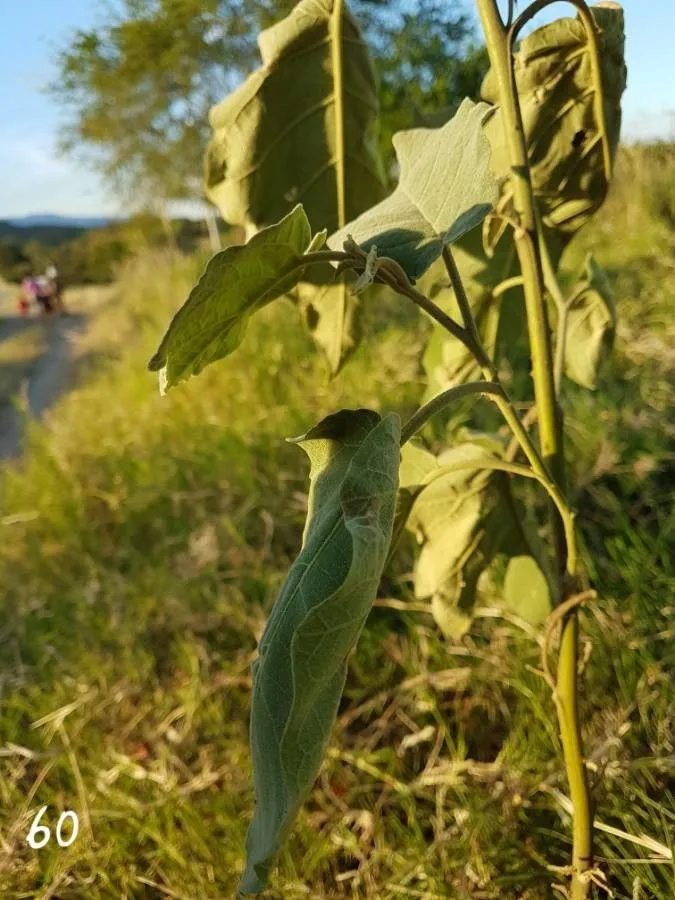
Author: D.Don
Bibliography: Prodr. Fl. Nepal.: 96 (1825)
Year: 1825
Status: accepted
Rank: species
Genus: Solanum
Vegetable: False
Observations: Trop. & Subtrop. America
The Tobacco-tree, scientifically referred to as Solanum erianthum, is a fascinating species belonging to the Solanaceae family. First described in 1825 by the botanist D. Don in the “Prodromus Florae Nepalensis,” it has since become known for its unique characteristics and widespread presence.
This versatile plant is prevalent in tropical and subtropical regions of the Americas. Its adaptability to various environments within these regions showcases its resilience and the diverse conditions under which it can thrive. Known commonly as the Tobacco-tree, it should not be confused with the tobacco plant typically used in the production of cigarettes.
Among its distinctive features, Solanum erianthum typically exhibits a robust structure with large, broad leaves and clusters of small, often white to pale yellow flowers. The foliage, resembling that of a conventional tobacco plant, is one of the reasons behind its common name. The flowers give way to berries that start green and ripen to a yellow or orange hue, a typical trait within the Solanaceae family.
The plant has historical and ethnobotanical significance, having been utilized in various traditional medicine practices by indigenous people throughout its native range. The leaves and other parts of the plant have been traditionally employed to treat a variety of ailments, although modern scientific studies on its medicinal properties remain limited.
Cultivation of the Tobacco-tree benefits from environments that provide ample sunlight and well-drained soils, mirroring its natural habitats. It adapts well to both wild and garden settings, making it a plant of interest not only for botanists and horticulturists but also for those looking to add a touch of tropical flair to their landscapes.
In summary, Solanum erianthum is a noteworthy member of the Solanaceae family, distinguished by its adaptability, distinctive appearance, and historical importance. Its presence across tropical and subtropical regions of the Americas highlights its ecological versatility and cultural significance.
Eng: china flowerleaf, big eggplant, flannelbush, mullein nightshade, potato-tree, potatotree, tobacco-tree, wild tobacco
En: Tobacco-tree, Wild tobacco, Big eggplant, Potato-tree, China flowerleaf, Flannelbush, Potatotree, Mullein nightshade, Tobacco Nightshade, Common Nightshade, Potato tree
Zh: Jia yan ye shu, 假烟叶树
Id: Terung teter
Ja: Yanbaru-nasubi
Kn: ಚೌಡಂಗಿ
Pt: Fumo-bravo, Capoeira-branca, Couvetinga, Cuvitinga (3)
Zh-tw: 假煙葉樹, 山煙草
Th: ฝ่าแป้ง
Zh-hant: 假煙葉樹
Vi: Ngoi
Taken Feb 18, 2021 by Shehadi Ramiz (cc-by-sa)
Taken Aug 22, 2020 by Pereira Jorge (cc-by-sa)
Taken Mar 1, 2020 by Noel Dionson (cc-by-sa)
Taken Mar 9, 2021 by Gnagbo Anthelme (cc-by-sa)
Taken Sep 3, 2022 by Jose Luis Grajeda Gonzalez (cc-by-sa)
Taken Jun 28, 2020 by Julia (cc-by-sa)
Taken Jan 27, 2014 by EOL − Kenneth Bader (cc-by-nc)
Taken Sep 19, 2019 by Sarah Smadja (cc-by-sa)
Taken Sep 19, 2019 by Sarah Smadja (cc-by-sa)
Taken Jan 9, 2015 by EOL − Carlos Velazco (cc-by-nc)
Taken Jan 31, 2021 by Myra Marin-Rodriguez (cc-by-sa)
Taken Jul 29, 2022 by Jo Hadley (cc-by-sa)
Taken Jul 29, 2022 by Jo Hadley (cc-by-sa)
Taken Mar 9, 2021 by Gnagbo Anthelme (cc-by-sa)
Taken Sep 19, 2019 by Sarah Smadja (cc-by-sa)
Taken Jan 1, 1900 by EOL − Acevedo, P. (cc-by-nc-sa)
Taken Jan 1, 1900 by EOL − Keystone Foundation (cc-by)
Taken Jan 31, 2021 by Myra Marin-Rodriguez (cc-by-sa)
Taken Jan 31, 2021 by Myra Marin-Rodriguez (cc-by-sa)
Taken Sep 19, 2021 by S. Amankwah Kwame (cc-by-sa)
Taken Feb 22, 2022 by Garofalo Vera (cc-by-sa)
Taken Jan 31, 2021 by Myra Marin-Rodriguez (cc-by-sa)
Taken Sep 19, 2019 by Sarah Smadja (cc-by-sa)
© copyright of the Board of Trustees of the Royal Botanic Gardens, Kew.
© copyright of the Board of Trustees of the Royal Botanic Gardens, Kew.
© copyright of the Board of Trustees of the Royal Botanic Gardens, Kew.
Growth habit>: Tree, Subshrub, Shrub
Family: Myrtaceae Author: (F.Muell.) K.D.Hill & L.A.S.Johnson Bibliography: Telopea 6: 402 (1995) Year: 1995 Status:…
Family: Rubiaceae Author: Pierre ex A.Froehner Bibliography: Notizbl. Bot. Gart. Berlin-Dahlem 1: 237 (1897) Year:…
Family: Sapindaceae Author: Koidz. Bibliography: J. Coll. Sci. Imp. Univ. Tokyo 32(1): 38 (1911) Year:…
Family: Asteraceae Author: A.Gray Bibliography: Pacif. Railr. Rep.: 107 (1857) Year: 1857 Status: accepted Rank:…
Family: Fabaceae Author: Medik. Bibliography: Vorles. Churpfälz. Phys.-Ökon. Ges. 2: 398 (1787) Year: 1787 Status:…
Family: Aspleniaceae Author: (Cav.) Alston Bibliography: Bull. Misc. Inform. Kew 1932: 309 (1932) Year: 1932…